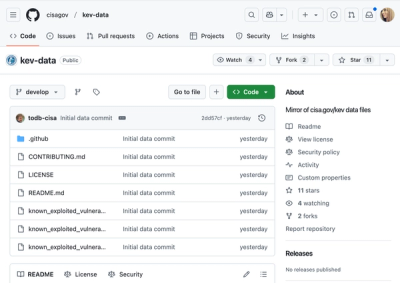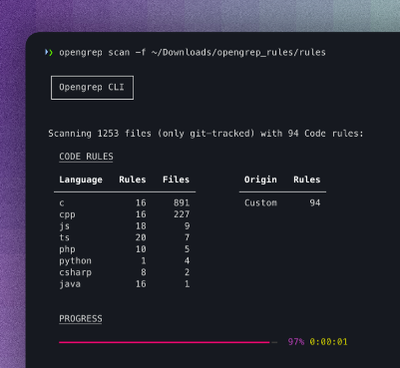
Security News
CISA Brings KEV Data to GitHub
CISA's KEV data is now on GitHub, offering easier access, API integration, commit history tracking, and automated updates for security teams and researchers.
…it's called TweetPony because I developed it with ponies in mind.
This program is licensed under the AGPLv3. See the LICENSE file for more information.
You can easily install TweetPony using the Python Package Index. Just type:
sudo pip install tweetpony
You can see the internal names of all the API endpoints in the file endpoints.py.
For example, to update your status, you would do:
status = api.update_status("Hello world!")
All the parameter names are the same as in the API documentation. Values will be automatically converted to their correct representation. For example, the boolean True will become the string true.
TweetPony has an internal model system which lets you perform actions related to the model quite easily!
Suppose you have a Status model:
status = api.get_status(id = 12345)
Now if you want to favorite this status, you would probably do this:
api.favorite(id = status.id)
But TweetPony makes this easier! You can just do:
status.favorite()
and the pony will favorite the tweet!
Of course, this will only work if you obtained the Status instance through an API call, which should be the case 99% of the time. It won't work if you create the Status instance directly from a dictionary. But why would you do that?
You can also manually connect an API instance to a model instance by using the model's connect_api method.
For example, if you have two API instances (e.g. for two different users) and want to fetch a tweet with the first user's account and retweet it with the second user's account, you do:
status = api1.get_status(id = 12345)
status.connect_api(api2)
status.retweet()
Look into models.py to see which methods exist for which models.
If you omit the paramater names in function calls, the order of parameters is as follows: First come all URL parameters / required parameters in the order they are listed in endpoints.py, then come all optional parameters.
For all API endpoints that take an image as a parameter, just pass the image file object to upload as the appropriate parameter and the pony will do the rest for you.
Multi-image uploading is supported too! Look into the endpoints.py and api.py files for details.
On error, TweetPony will raise either an APIError, NotImplementedError or ParameterError exception.
An APIError instance has the following attributes:
code: The error code returned by the API or the HTTP status code in case of HTTP errors
description: The error description returned by the API or the HTTP status text in case of HTTP errors
NotImplementedError and ParameterError instances have only one attribute, the error description.
Almost every API call (except for the ones that return only a list or something equally simple) will return a parsed model instance representing the response data.
There are User, Status, Message, List, APIError and many more models.
You can access the response data as instance attributes like status.text or using a dictionary lookup like status['text'].
You can either pass your access token and access token secret when initializing the API instance or go through the normal authentication flow. The authentication flow works like this:
api = tweetpony.API(consumer_key = "abc", consumer_secret = "def")
auth_url = api.get_auth_url()
print "Open this link to obtain your authentication code: %s" % auth_url
code = raw_input("Please enter your authentication code: ")
api.authenticate(code)
After you've done this, the access token and access token secret can be obtained from the API instance as api.access_token and api.access_token_secret.
By default, TweetPony loads the authenticating user's profile as soon as all four authentication tokens are present. This is also a way of checking whether these tokens are correct. If you do not want the user to be loaded, pass load_user = False to the API constructor.
This is useful if:
verify function of the API instance)This is a simple example script. More can be found in the examples directory.
import tweetpony
api = tweetpony.API(consumer_key = "abc", consumer_secret = "def", access_token = "ghi", access_token_secret = "jkl")
user = api.user
print "Hello, @%s!" % user.screen_name
text = raw_input("What would you like to tweet? ")
try:
api.update_status(status = text)
except tweetpony.APIError as err:
print "Oops, something went wrong! Twitter returned error #%i and said: %s" % (err.code, err.description)
else:
print "Yay! Your tweet has been sent!"
FAQs
A Twitter library for Python
We found that TweetPony demonstrated a healthy version release cadence and project activity because the last version was released less than a year ago. It has 1 open source maintainer collaborating on the project.
Did you know?

Socket for GitHub automatically highlights issues in each pull request and monitors the health of all your open source dependencies. Discover the contents of your packages and block harmful activity before you install or update your dependencies.

Security News
CISA's KEV data is now on GitHub, offering easier access, API integration, commit history tracking, and automated updates for security teams and researchers.

Security News
Opengrep forks Semgrep to preserve open source SAST in response to controversial licensing changes.

Security News
Critics call the Node.js EOL CVE a misuse of the system, sparking debate over CVE standards and the growing noise in vulnerability databases.